|
San Juan Island
Administrative History |

|
CHAPTER 6:
Interpretation and Visitor Use
The Pig War story offers many themes: the international settlement of a territorial boundary dispute as the frontier filled with settlers, miners, and entrepreneurs; diplomatic relations with Britain as frontier borders closed; a unique view into American and British military history, from political maneuvering within ranks to differences in camp structure and life; and an understanding of American and British settlers along the frontier's edge. Park resources also make possible interpretation concerning the patterns of life among Northwest Coast American Indians prior to European settlement. Beyond its historical resources, visitors can experience a variety of natural resources, from forest to prairie, clams to eagles, offering multiple environmental educational opportunities.
The main question for interpretation at the park has been determining what programming is possible with the staffing and funding available. The park has come to rely on a group of very dedicated volunteers, whose contributions range from providing evening lectures to maintaining the garden at English Camp, to being available at the park to give guided walks and speak with visitors. Increasingly, this is becoming the way of life across the park system, as budgets become tighter and managers have to find new ways of providing interpretation to the public. Interpretive planning documents have been completed for the park, but a small percentage of action items in those plans have actually been realized. In practice, interpretation has revolved around motivated individuals who pursued interpretive programs with the research, staff, and volunteers available to them.
Interpretive Prospectus, 1971
The first interpretive prospectus for the park was approved in January 1971 by Pacific Northwest Regional Director John A. Rutter. The ideas in the plan were developed during an on-site meeting, October 26-28, 1969, by a NPS planning team consisting of Superintendent Stoddard; historian John Hussey; landscape architect Ron Treabess; and interpretive planner Alan Kent, from Harpers Ferry Center. Reed Jarvis, Erwin Thompson, Marvin Sharpe, and Rhoda Anderson are also listed as providing assistance.
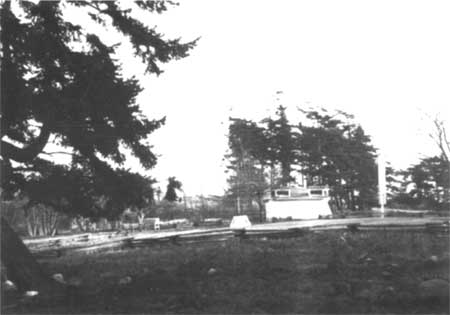
|
| The American Camp interpretive shelter, c. 1971-1972 |
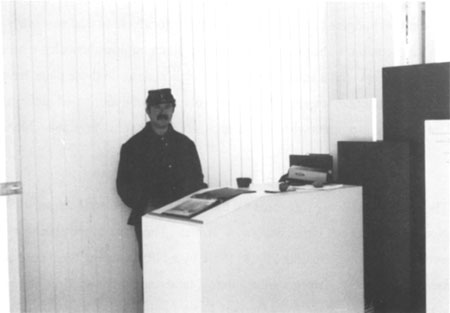
|
| Ranger Fred Stevens in uniform at the interpretive shelter. |
The document presents the park's major interpretive theme to be the Pig War, "its cultural and political circumstances, and most important, the idea . . . that discord and dissension between nations can, if subjected to rational behavior, lead to justice and friendship and a feeling of well-being, and also to a realization of the senselessness of freewheeling attitudes and clashes of arms." [1] The prospectus identifies, as an extension of that interpretive theme, the life of Jim Crook and his family, who settled at English Camp and lived there nearly a century. The life and work of Jim Crook is defined as a secondary theme for park interpretation.
The document advises against overkill and throwing "thousands" of facts at visitors. It suggests gearing programming towards families and young people: "arouse the kids and you've got the parents." [2] After a brief lecture on interpretive theory, the document sets out primary objectives: provide prospective visitors with some idea of what the park is about and give them information about visiting it; give visitors an idea of the San Juan Island diplomatic question involved in the dispute (being careful to show the passionate stand of both sides without taking sides); use the sites themselves to highlight the park story (interpretation should be carried out at and in the structures that exist and at the sites where structures once stood); highlight the U.S.-Canadian friendship in interpretive programs (stress how the two countries have utilized peaceful means of settling grievances); recognize the part Jim Crook played in preserving English Camp, including environmental elements of the story; satisfy visitor curiosity by identifying landmarks that can be seen from overlook points at both camps; and finally, provide visitors with a sense of the environmental values of the camps, and "include some musings about the quality of the world we live in".
The document offers several interpretive proposals for the park, presenting its interpretive themes from the viewpoint of a family. The team also tried to follow a structured visit, although the authors acknowledged that the nature of the park prevents the assumption that visitors will stop at one camp prior to the other.
First, the document identified pre-visit interpretive needs, including: development of a "../colorful, nicely designed exhibit for each of the ferries, for the Seattle-Tacoma airport, and for the ferry landing in Anacortes" and a park leaflet for travelers as well as a poster to be placed at points that do not warrant a "full-fledged exhibit." These exhibits would define the purpose of the park and describe available facilities and access routes.
The document suggested signage placement at the Friday Harbor marina similar to the exhibit or poster idea developed for ferries and at the terminal in Anacortes. Development of a shuttle system is suggested, encouraging visitors to leave their cars on the mainland and reduce congestion. The prospectus states that such a system could be developed by resort owners or some other private enterprise. Development of an appropriate signage system, incorporating the park's emblem of crossed American and British flags, would direct visitors from Friday Harbor to the two historic camps.
As identified in the master plan, the prospectus recommended an information center in Friday Harbor to include administrative offices for park staff, restrooms, two large photo enlargements of the camps, an attendant, information/sales desk with a map as well as other area information, a publications stand, and storage space. It also recommended providing a stand-up A/V presentation of five minutes or less in an alcove. The purpose of this program would be to orient the visitor to the island and the park, describe what facilities and activities are available to them, with some information about the Pig War interwoven throughout the story. Use of a sound/slide system was recommended, one that could be converted to film later if desired. The first floor of the Mason's Building was suggested for the information center.
The prospectus discussed American Camp first on the theory that most of the historical action occurred at this site and "the events of 1859 are most readily understood here" and that English Camp will be the most impressive of the two park sites and this method of visitation would be saving the "jewel for last". [3]
Development suggestions for American Camp included construction of a visitor facility that would be staffed in the summer season and provide information, publication sales, and restrooms. The major interpretive element would be a three to four minute film that presented the park story in its "largest context" from the American viewpoint, including commentary on world events during the conflict using an American reporter like Walter Cronkite to narrate. The prospectus outlined a lot of information to be included in this three to four minutes and acknowledged the tall order of the recommendation. The film would be contrasted with a similar presentation of the "British Case" at English Camp utilizing the same type of information from the British viewpoint and with a British or Canadian version of Walter Cronkite narrating. The prospectus recommended use of existing historical photos in the presentations and researching the possibility of using art as the primary medium. At the end of each film, the visitor would be encouraged to visit the other camp.
The prospectus forgoes exhibits at the American Camp facility other than a map for information purposes. It does offer items to consider for future displays, like archaeological material or even timbers from the Hudson's Bay Company (HBC) farm.
The proposal recommended a two minute audio presentation at the Redoubt site highlighting events in relation to the sites where it actually took place. Trails to the HBC farm and other sites should be developed, including a spur trail to San Juan Town. The overlook site should also have an "orientation device," identifying the major physical features across the waters from the island. The Redoubt should be restored to its appearance of 1859-60 and replica guns mounted. Wayside exhibits explaining its construction should also be developed. Living history opportunities included demonstrations of period American Camp soldier equipment. Wayside exhibits utilizing historic drawings and sketches of the site could be placed at the sites of Bellevue Farm, San Juan Town, and other camp structures, relying on archeology to reveal these sites for proper identification. The prospectus also suggests allowing grazing sheep at the Bellevue site to further develop the historic scene.
The "Pickett House" should be moved back to the site, restored, and eventually refurnished to show how an officer would have lived during those years. At the very least, the fence that surrounded the compound should be reestablished allowing visitors to easily identify where the buildings (visible in period drawings) existed on the ground.
At English Camp, the prospectus recommended a visitor facility, staffed with a sales and information desk, and restrooms, a historian's office, small library, and storage area. It should be located in a space that is visually separated from the historic setting. Exhibits could include a historic painting of the camp and Royal Marine documents. As stated earlier, there would be a short film for visitors to view.
Other recommendations included the need to restore the barracks, blockhouse, and storehouse (commissary) with the barracks selectively refurbished to represent the Royal Marine life. On display could be uniforms, gunracks, tables, bunks, and games. The document also suggests utilizing audio of voices (talking about the barracks in someway) and smells, although it does not specify what those would be. The blockhouse and storehouse could be similarly equipped, taking advantage of "olfactory" opportunities and audio of "characters". [4]
The document also suggests stabilizing the masonry ruin; locating and identifying other building sites; re-creation of the flagpole; reproduction of the historic garden; and possibly reconstruction of the wharf. The historic setting of English Camp afforded ample opportunity for living history demonstrations, specifically activities of daily life at the camp (cooking, games, carving, work in the gardens, etc.). The report stressed that interpretation should detail the activities of military life during their 12-year peaceful occupation of the island. The prospectus recommends examining Fort Davis' military demonstrations for possible programs at English Camp. It is interesting to note that in 1971, they were considering tearing down the Crook House, despite the popularity of Jim Crook in local island history and the fact that islanders, during public hearings and comments on park establishment, had specifically requested interpretation of Crook's history at English Camp.
Wayside exhibit and foot trail opportunities included the captain's house, the cemetery, and the historic maple tree. During restoration and archaeological work, temporary waysides should be developed to educate visitors about preservation and archaeology at the park.
The prospectus concludes by listing the best sources for historical research about the park, offering a list of research needs, a suggestion for a commemorative stamp for the 1972 boundary settlement centennial, and a collections statement. Research needs identified include: information on specific historic furnishings, research for audio/visual productions, and material on Jim Crook.
The collections statement defines park collecting as supporting the park interpretive theme and objectives. A large collection was not foreseen, consisting mainly of archaeological and historical artifacts kept for documentation purposes. Historical items associated with the Pig War and the military occupation were to be collected for exhibit purposes. Furnishing plans would determine what should be collected with regards to historic and replicated furnishings for building interiors. Demonstration programs would require the collection of replicated materials for use. Items of relevance to Jim Crook should be preserved, like the existing implements and inventions in park possession. The prospectus states "when the Crook House is torn down," the doors should be saved (speculated to originally be off the captain's quarters) and any other pieces believed to have come from original English Camp structures. Beyond items already in possession of the park, no further materials on Crook should be collected.
Lastly, the prospectus offers a suggestion by Superintendent Stoddard that the park provide programs around a campfire setting, recommending the master plan be revised to include a "campfire circle" at each site. When done, the prospectus could then be revised to include development of programs.
In addition, Superintendent Stoddard provided recommended staffing levels for the implementation of the prospectus interpretive goals. His recommendations called for a Superintendent, an Administrative Officer, an Information/Receptionist position, and one seasonal in Friday Harbor; one Park Ranger and two seasonals at American Camp; and a Chief of Interpretation and Resources (historian), three seasonals, one permanent maintenance position, and one seasonal maintenance position at English Camp. Staffing recommendations also suggested the development of an exchange program with the Canadian Park System, which would bring Canadian seasonal interpreters to the park in order to present different viewpoints to visitors.
The interpretive prospectus was written during the early development stages of the park, and contained the ideas planners envisioned for the park. In a sense, it is the wish list for park interpretation. The cost estimate in 1971 for completion of the park interpretive plan: $122,700.
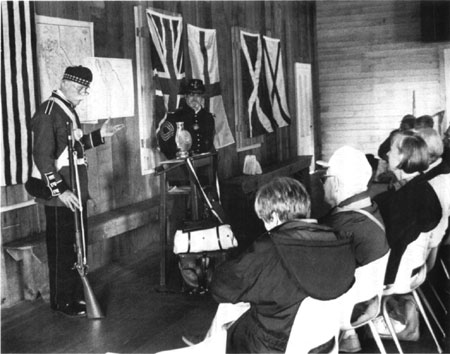
|
| Volunteer Jim Meredith speaking in costume at the Barracks, English Camp. Volunteer Ted Leche looks on. |
Interpretive Prospectus, May 1984
A new interpretive prospectus was developed by Harpers Ferry in 1983-84. It begins by stating that although the park was authorized seventeen years before, it remains underdeveloped in terms of interpretive media and visitor facilities, which became increasingly apparent as visitation to the park continued to grow significantly over the years. [5] The General Management Plan of 1979 proposed an interpretive contact station be built at American Camp, but as of 1984, no such interpretive facility was programmed for construction.
In planning the park's interpretive media, geographic location and climate were factors considered. The island location, combined with its size and population meant that interpretive media supplies would be time consuming and more expensive to replace. Therefore all hardware used should be highly reliable and not have highly specialized components. Also, the moisture fluctuation, salt corrosion, and strong winds at the southern end of the island were taken into consideration for signage design.
The prospectus aimed its proposals at expanding the park's orientation and information capabilities. The park currently had the headquarters building at American Camp (which had an information counter but no lobby space); the office in Friday Harbor; and the barracks building at English Camp (which had some small exhibits and audio/visual program equipment). Other identified programming needs included: trailhead orientation for the park's three hiking trails; the one self-guided interpretive trail; and proposals for visitor transportation between the park's two units and the town of Friday Harbor.
Working under the park's primary interpretive theme, the prospectus identified the following objectives for park interpretation:
provide information/orientation to assist visitors in locating points of interest and what they can see and do during their visit;
provide basic information on interpretive themes to all park visitors and provide opportunities to acquire more than just basic information for those visitors who wish it;
protect all natural and historical features of the park through a positive interpretive program emphasizing protection;
protect visitors by informing them of safety hazards inherent in the American Camp prairie due to rabbit warrens and reminding them of the need for safety while touring the park; and
provide the opportunity for all visitors to relate to history by having interpreters located at both camp units.
Within these parameters, the prospectus begins by presenting primary and secondary interpretive program elements and the methods and locations by which the park should present those elements.
Primary elements dealt with orientation/information and the Pig War. Pre-arrival orientation programming included signage on Interstate 5 and orientation exhibits at the Anacortes ferry terminal. Centralized orientation would be provided through personal services, brochures, and other printed materials, and orientation exhibits. These elements would be provided at the Friday Harbor contact station, the American Camp contact station (headquarters building), and at English Camp contact station (identified here as the Crook House). In-depth interpretation of the Pig War would be provided at American Camp, via personal services, audio/visual programs, advanced level publications, the self-guided interpretive trail, interpretive exhibits, restored historic structures, and hiking trails. Interpretation at English Camp would be via personal services, publications, wayside exhibits, restored historic structures, historic furnishings (partial) in three buildings, interpretive exhibits, and hiking trails.
Secondary program elements identified were cultural history and natural history. Parkwide, these interpretive stories would be provided via personal services and publications. English Camp secondary stories included development of museum exhibits at the Crook House and wayside exhibits at Bell Point trail and trailhead.
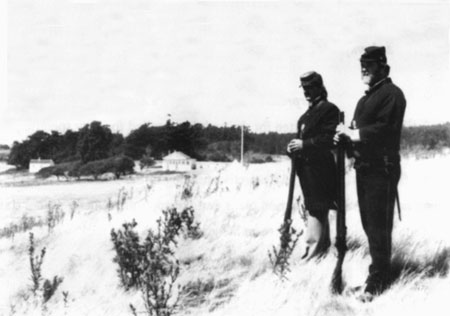
|
|
1985, American Camp costumed interpretation VIP Mike Cusson and Park Ranger Ron Garner |
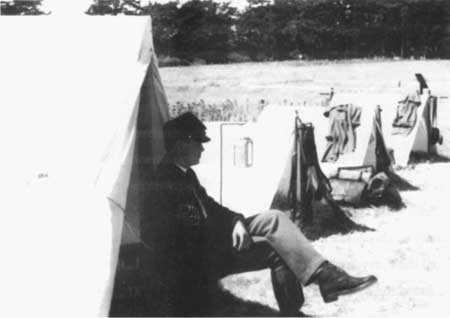
|
|
1985, American Camp costumed interpretation Terry Lattin resting in camp |
Interpretive Programming in Action
The interpretive plans written for the park have called for very specific points of action and development. However, the first interpretive plan resulted in minimal activity. The 1984 plan fared a little better. Interpretive funding at San Juan Island N.H.P. has gone into designing and programming action plans, but the appropriate budgets and staff were not available to follow through with the recommended actions. The park has spent a great deal of time restoring and maintaining structures and considering the historic landscape. Park staff also developed quality interpretive programs through living history demonstrations, lecture series, and film and slide presentations, despite the lack of adequate funds. In 1996, work started on a new, long-range interpretive plan. By integrating the interpretive plan with the park's resource management plan and eventually a new general management plan, the park hopes to provide important support and funding for park programs.
From 1971 to 1975, PNRO staff under Rocky Richardson developed exhibit panels for the Barracks and wayside exhibit trail signs. Developed under contract with EAMS, a private design firm in Seattle, the signs detailed the major events and characters of the Pig War and the joint military occupation of the island.
With the addition of Pat Milliren in 1975, interpretive programs began to grow. Milliren was the first ranger hired specifically for interpretation and she began developing more involved programs at both camps. Her goals were to improve relations with the community and get the community involved in the park. When living history demonstrations were introduced, Milliren sought out people with specific skills or talents like the ability to play historic music and dance or theater skills. Most importantly, she sought to tell the everyday stories of the military encampment, an aspect of the historical period she found the most interesting, a story the public could relate to and invest in.
Summer Saturday evening programs were started, with the park inviting local and regional speakers to talk on historical or natural history topics, or showing films like those of Edward Curtis. For the first time the park entered the annual 4th of July parade. A very popular program developed under Milliren was the 1860s Christmas party at English Camp.
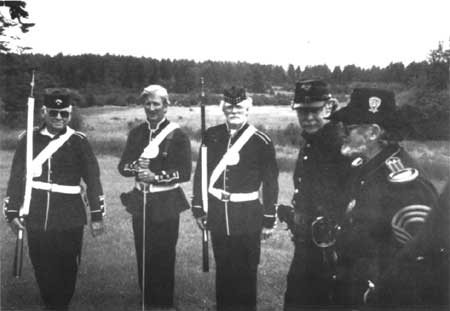
|
|
Getting ready to march in the Fourth of July
Parade: (Park Ranger Mike Vouri, 2nd from right, former park ranger Detlef Wieck, 3rd from right) |
Milliren remembers receiving considerable support from parks back east when developing living history demonstrations. Because the park's historical period is the same era as the civil war, information on military life, costuming, etc. was readily available. [6] Presentations on army life were also made available during 1984-85, when re-enactors of the 9th infantry performed for one or two weekends during the summer. Many local volunteers, throughout the park's history have offered lecture-walks along the park's self-guided interpretive trail. Recently, demonstrations have been offered in skills such as blacksmithing and barrelmaking.
From 1975-81 and picking up again in 1986, park staff had the freedom and the creative individuals to write and perform scripted costumed demonstrations. Milliren began this with the re-enactment of a Captain's wife's letters home. Later, rangers Detlef Wieck and Mike Vouri scripted re-enactments and performed them in costume.
During the 1970s, local VIP and later park ranger Steve Layman did a lot of work with bald eagles at the park, including environmental education programs with the Seattle zoo. These programs brought field trips from area schools to American Camp for eagle programs. The self-guided interpretive trail, the exhibit shelter, and trailhead signage were all that existed in the way of interpretation at American Camp prior to 1974. Milliren remembers it being very difficult to put on demonstrations due to low visitor numbers.
In 1984, new exhibit opportunities expanded when the main administrative offices relocated to Friday Harbor. The move allowed half of the headquarters building at American Camp to be used for visitor exhibit and lobby space. The outdoor interpretive shelter panels were cleaned and moved inside the new visitor lobby, complemented by historical photographs. The Friday Harbor contact station also provided new display space and increased public visibility. Exhibits there included two mannequins in historic military dress of the Royal Marines and U.S. Army. In 1992, the English Camp barracks exhibits were moved to Friday Harbor and the costumed mannequins were subsequently relocated to American Camp in 1996.
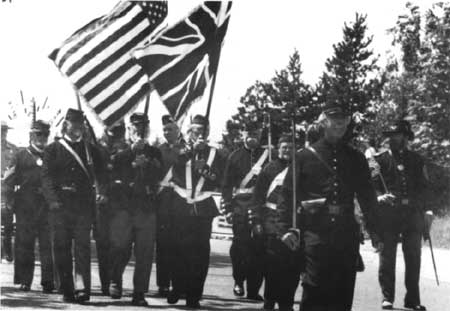
|
| Marching in the Fourth of July Parade. |
The exhibits at American Camp remained until 1995-96, when a new wall panel interpreting the Oregon Treaty was loaned to the park by the British Consul in Seattle.
Then in 1996, park ranger Mike Vouri, coordinating with collections curator Camille Evans of North Cascades National Park and other park staff, worked to design and construct exhibits drawing on the park's archaeological collection. Cases were made from locally donated materials, and photos and text describing archaeology at the park over the years were used to complement artifacts selected for display. The new exhibit has been a success and is a tribute to park staff pulling together to build good interpretive programs without additional funding.
Another source of interpretive opportunities has come from the archaeological field schools. From 1983-89, the University of Washington field schools conducted regular visitor services programs on the archaeological work underway at the camp. These programs were well received by the public.
In 1986, the park celebrated SAJH 20, the twentieth birthday of the park. To coordinate the event, a committee was formed of park personnel and community members. Special events included special programs at Christmas, the community restoration of Salmon Banks Road, final reconstruction and replanting of the formal garden under volunteer efforts, a 4th of July parade float (for which the park received first prize), a park-staged historical drama, and a Founder's Day picnic open to the public, which was hosted by the park and supplied by other community organizations like the Lions, the Chamber of Commerce, and others. Volunteer efforts jumped under the SAJH 20 celebration, from 47 to 140. The celebration was designed to celebrate the park and its relationship to the community. If the increase in volunteer numbers was any indication, the program was a success.
During the late 1970s and 1980s, the park typically had 3 to 4 seasonals for the interpretive program. Volunteers have increasingly become important to providing on-site, staffed visitor services. For example, local island residents Jim Meredith and Fred Henley have dedicated countless hours over the years as interpreters and guides at English Camp, where seasonal presence has typically been low. In the winter months the two men have conducted an Elderhostel program in conjunction with Skagit Valley College. Since the mid-1980s, however, seasonal staffing levels have declined and in recent years it has been a struggle for the park to maintain one or two paid seasonal interpreters. For that reason, park staff must consider developing more non-personnel visitor services. A new guide for a self-guided tour at American Camp was completed in 1996. This new brochure increased the level of information available to park visitors at any time of day without a park ranger or volunteer, and can be completed at the visitor's own pace. An after hours brochure and a variety of site bulletins were developed to serve the needs and interests of an increasingly diverse visitor population.
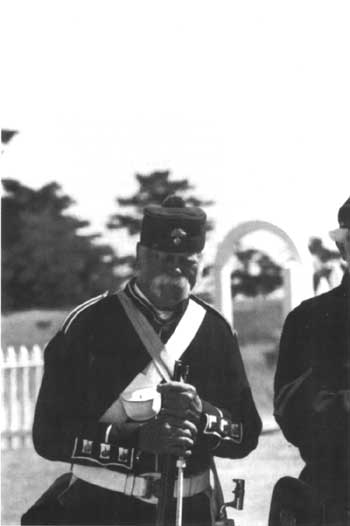
|
| Jim Meredith, park VIP, in Royal Marine livery. |
The park received a big boost in developing an outreach interpretive program in 1996. The park was awarded a $13,500 grant from the National Parks Foundation for the development of a travelling trunk exhibit. Working with regional consultants, the park will develop the trunk for travel to regional schools, extending the park's interpretive outreach well beyond the island community.
The park reached out to the world in 1998 with the establishment of an official World Wide Web site containing both historical and full color photographs. An enhanced, changeable site features historical structures, wildlife, and spectacular vistas at both camps. Outreach has also been enhanced through partnerships with the British Consulate Seattle and the San Juan Community Theatre and Art Centre in Friday Harbor. In March 1997, the three teamed together to bring a performance of the pipers from the King's Own Scottish Borders, a British Army regiment recruited in Scotland. The band played to a packed house, preceded by a parade down Spring Street. The park and the theater split the gate. The park and theatre also teamed up in 1996 to produce "An Evening with George Pickett," a one-man show featuring Park Ranger Mike Vouri in the title role and volunteer Mike Cohen on the banjo.
In the mid-1970s, visitation was around 65,000 a year, climbing to over 100,000 a year in the early 1980s. Visitation in the 1990s has reached beyond 200,000. In 1996, 227,104 people visited the park. [7] As visitation has grown, the number of seasonal interpreters has dwindled. Currently, the park is ready for a new interpretive plan to provide guidance in all areas of interpretation, including defining and maintaining historical landscapes to enhance visitor experience, optimizing non-personnel visitor services, and developing new and improved programming for park visitors.
English or British Camp?
When San Juan Island N.H.P. was created in 1966, the NPS acquired English Camp and American Camp, names that had been used almost exclusively since the turn of the century. However, in 1986 the park began to question the accuracy of calling the camp inhabited by the Royal Marines "English."
For the record, the Marines referred to the camp as the "Royal Marines Camp". [8] If one searches the historical record outside of Royal Marine documentation for citations of the camp name, there is plenty to show support for both British and English Camp. [9] Historical accuracy is the issue for those who consider "British" a more appropriate title. They contend that all members of Her Majesty's Royal Marines were not English; they were also Scottish, Irish, or other nationalities from within the British Empire and even beyond. [10] Therefore, the "English" title does not convey the multi-national make-up of HMR Marines, whereas "British" associates the camp with the people represented by the British empire.
The idea of changing the name to reflect this historical accuracy came about in the 1979 General Management Plan, which throughout refers to British Camp, and on page 34 states that all development and interpretation will use the name British Camp. The NPS began researching the name due to visitor comments regarding the topic: most specifically, strongly felt comments from visitors who were from Great Britain, but were not English. Enough popular opinion was received to motivate the use of the name which better reflected the people stationed there.
In 1986, park management made the decision to change the name to British Camp and updated all brochures and interpretive signage to reflect its use. Reaction to the change was not seriously felt until 1992, when the Board of Commissioners for San Juan County and the United States Geological Survey petitioned the Washington State Board of Geographic Names to change all maps to reflect the name British Camp. At this point, a few local residents campaigned the state board and the county to stop the name change on the grounds that the site had always been English Camp. One letter even stated that it had never been called British Camp until the park service showed up on the island. The tone of the opposition was very much "islander" vs. "outsiders" attitude. The noise raised was enough to make the county commissioners back away from the name change on the grounds that they didn't realize opposition existed. The Washington State Board of Geographic Names saw enough opposition to reject the name change on the grounds that it was too controversial and the state board concluded that the site should retain its traditional name.
Prior to their decision, park managers declined to research the impact the change would have from a public relations standpoint. Following the decision by the state board, the park changed the name back to English Camp, with the hope that through a better outreach and educational process, the name issue can be properly addressed again sometime in the future. Names can be a serious business; time, money, effort, and, for a few people, strong emotions were spent on this issue. For the park, it meant programming funding to change its brochures and signage twice.
| <<< Previous | <<< Contents>>> | Next >>> |
sajh/adhi/chap6.htm
Last Updated: 19-Jan-2003